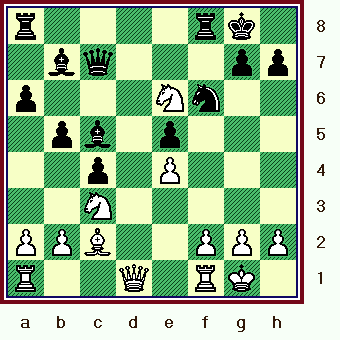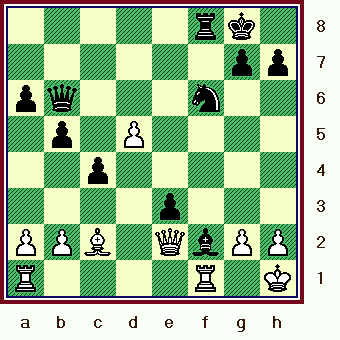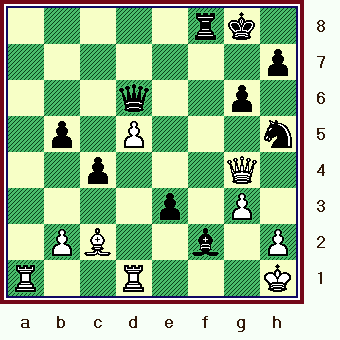GM Rustam Kasimdzhanov (2678) -
GM Garry Kasparov (2804)
[D47]
XXII
Super-GM Tournament (XXII
Torneo Ciudad de Linares)
Linares, ESP; (Round
# 09), 04,03,2005.
[A.J.
Goldsby I]
Kasparov
devastates the current FIDE Champion ... they will be talking about this
game for a very long time! (This might also be the most important
theoretical discovery of the last 10-15 years, it will drastically alter
the whole assessment of this entire sub-system.)
I also watched this game 'live' via the
Internet, it was truly a treat to behold!!
****************************************************
1.d4 d5;
2.c4 c6; 3.Nc3 Nf6; 4.e3 e6;
Super solid play - so far.
(This is a double-QP opening ...
and we are headed for the very
popular "Semi-Slav.")
5.Nf3 Nbd7;
6.Bd3,
The Meran System.
[ As White, Garry likes the
following line from here:
6.Qc2!? Bd6; 7.g4!
"/\" {Diagram?}
(Reference the Kasparov vs. Deep Junior match,
see my website about this event:
"The
Human's Home Page," A.J. on chess, computers and a lot of
other stuff.)
It would have been interesting to
see just how Kasparov would have
defended his favorite line ... but
from the opposite side of the board. ]
The next series of moves is
pretty much all 'book' here.
6...dxc4;
7.Bxc4 b5; 8.Bd3 Bb7; 9.0-0 a6; 10.e4 c5; 11.d5,
"+/="
This is called ...
"The Reynolds Variation," and
is one of the most crucial and hotly
debated lines in modern theory.
[ See MCO-14, page # 461;
columns 13-18, and all notes. ]
[ White can also play:
11.e5 cxd4; 12.Nxb5!,
{Diagram?}
with incredible complications.
[ See MCO-14, page # 459;
for more information on this line.
{All columns and all notes.} ]
]
We continue to follow a known
path from this position.
(White can
play Ng5 or Nd4 on his fourteenth
turn, and I doubt if it makes any
real difference.)
11...Qc7;
12.dxe6 fxe6; 13.Bc2 c4;
A good place to stop and try to
assess this position. Who is better,
and why? Will Black's weak KP
play a significant role? Or is the
fact that Black has gobbled up a
great deal of Queen-side space ...
the most important factor? (Both
sides have open lines, as this game
clearly shows, the half-open
f-file is crucial for Black's play.)
A good discussion of this position ...
and a very deep analysis of all the
key lines ...
can be found in GM
Peter Wells's excellent book.
[ See "The Complete Semi-Slav." (1994)
Chapter # 14, page # 136. ]
14.Nd4!?,
(hmmm)
One of the more commonly played
lines in tournaments today.
(For
whatever reason or reasons, this
move today is seen to be preferable
to playing this piece to g5.)
[ White can also play:
14.Ng5
Nc5; 15.e5!? Qxe5; 16.Re1 Qd6;
17.Qxd6
Bxd6; 18.Be3 0-0!?; 19.Rad1, "+/="
{Diagram?}
White has a small, but clear edge.
(At least according to standard opening
theory ... from this position.)
See the GM contest:
Anatoly Karpov (2740) -
Vladimir Kramnik (2710);
ICT / Super-GM (Round 12) /
Linares, ESP; 1994.
(1-0, 40 moves.)
{White won a convincing game.}
***
( One of the most popular of all the
reference books, provides us with
the following interesting line - after Rad1 here:
19...Be7!; {Diagram?}
The end of the column.
20.Bxc5 Bxc5; 21.Nxe6 Rfc8; 22.h3!? Rab8!?; 23.Nxc5!?,
23...Rxc5; 24.Re6!? b4; 25.Na4 Rg5; "~" {Diagram?}
MCO calls this equal, I prefer to
say it is unclear, Fritz 8.0 allows
Black a slight edge here.
GM Vladimir Kramnik (2725) -
GM Alexei Shirov (2740); [D48]
ICT / Super-Masters (Round # 2) /
Novgorod, RUS; 1994. (1/2-1/2)
{The game was drawn in 30 moves.}
(I think I remember seeing this game
annotated in the "Inside Chess" magazine.)
[ See MCO-14, page # 464;
column # 23, and also note (q.). ] ) ]
14...Nc5;
I have a CD-ROM on the Semi-Slav.
I checked it here - there were over
300 games that
arose from the
current position, although not all of
these were master-level contests.
(Over 100 quality games, when you
check the ChessBase server ...
using the position
{above} as the
sole search criteria.)
15.Be3 e5!;
At one time ... theory considered
this move to be very inaccurate.
(Of course, this all changes now,
especially after just this one game!)
16.Nf3,
(hmmm)
Seemingly - this is the best and
the most natural square to retreat
this piece to.
(This is also the square
endorsed by modern opening theory.)
[ Also possible was:
16.Nf5!?,
{Diagram?}
---> this move looks reasonable,
and the computer likes it ...
I am not sure how opening theory
would view this move. ]
16...Be7;
17.Ng5 0-0!!; (TN)
"This is Kasparov's novelty, leaving
the e6-square open for a fork." - ChessBase
Previously - - the move ...h7-h6;
was thought to be obligatory here. (!!!!)
[ The 'book' continuation ... at least
prior to this game ... was:
17...h6!?; (Box?)
18.Bxc5 hxg5; 19.Be3 g4;
20.Qe2,
20...0-0-0;
21.a4, "~" (Maybe
"=/+" ) {Diagram?}
and according to theory, White
was slightly better here.
(I do
not happen to agree with this
particular assessment here!)
This was based on the following
key master encounter:
GM Yuri Kruppa
(2572) vs.
IM Didier Collas (2430);
[D48]
ICT / Cappelle Master's Open
/
Ville de Cappelle-la-Grande,
(near Dunkerque) /
FRA; 2001.
{White won a nice game, 1-0
in just 37 total moves.} ]
18.Bxc5,
This move obviously "destroys
(Black's) defender" ... ... ...
of the e6-square.
[
Or 18.Qe2!?
Qc8; "=" {Diagram?}
but Black has no real problems
in the position on the board now. ]
18...Bxc5;
19.Ne6; {See
the diagram given - just below.}
This is obviously a fork of Black's
Queen, (and also his Rook as well).
There was no turning back, as
any other continuation was going
to be quite favorable for Black.
**************************************
**************************************
White
is winning an exchange with this move ...
did Kasparov blunder, or make
a miscalculation to arrive at this position?
[
(</=) 19.Qe2!?
Qe7; "=/+"
]
Now
several GM's - on one
Internet server - were saying that
Black should play ...Qc6 here.
19...Qb6!;
20.Nxf8 Rxf8; 21.Nd5!?, (Maybe - '?!')
A lot of the fish and kibitzers
(on one chess server), were
clamoring that this was a good
move for White ... and that now
Garry was losing. In actuality,
this move might be inaccurate.
[ Maybe better was:
21.Qe2,
"~" {Diagram?}
or even h3 ... to keep that dangerous
Black Knight off the g4-square. ]
Now Garry gets really nasty.
21...Bxd5;
('!') 22.exd5 Bxf2+!;
23.Kh1[], (hmmm)
Of course this is completely
forced for White here.
[
Of course not:
</= 23.Rxf2?
as 23...Ng4!;
will win easily for Black. ("-/+")
(QxN/g4?? is easily met by the
simple capture of the WR (on f2)
by
the Black Queen ...
followed by a rapid mate.)
( One sample line would be: 23...Ng4; 24.Bxh7+!? Kh8!;
25.Qe1 Nxf2; 26.Qe2 Nd3+; 27.Kh1 Kxh7; ("-/+")
{D?}
and Black is a piece ahead ...
with a relatively easy win. ) ]
23...e4!?;
(Maybe - '!')
At first this move looks to be a
careless one ... but Garry has
probably worked a lot
of this out
in his home {analysis} lab.
[ Also promising was:
23...Bd4;
24.Rb1 Qd6; 25.Qf3 g6!;
"=/+" (Maybe - "/+")
{D?}
with a clear advantage for Black.
]
24.Qe2 e3;
(comp?)
{See
the diagram given, just below here.}
Garry Kasparov's plan for this
position has now been revealed.
**************************************
**************************************
For
starters, Black has one Pawn
and a minor piece for the exchange.
With the Black Bishop anchored on
f2, and White's d-Pawn looking like
...
... "a dead man walking," it seems
that Black's exchange sacrifice has
definitely
worked out well for Garry.
25.Rfd1,
Seemingly - a very natural move ...
[
Or if
25.Bf5 Kh8;
"~" (equal?) {Diagram?}
[If 26.Be6!? then 26...Ne4; and
I prefer Black's
chances from
this position.] ]
Now Black could play ...g6 here,
which prevents White from playing
the maneuver
of B-to-f5-e6+, etc.
(Garry has different ideas, first he
improves the position of his
most
powerful piece.)
25...Qd6!?;
26.a4!? g6!;
An excellent move ... for a lot
of different reasons. It blocks the
White Bishop on the b1-h7
diagonal,
gives the BK {BK
= Black King} some elbow room,
and also prepares ...Nf6-h5.
27.axb5 axb5;
28.g3!?, ('?!')
In my opinion, this move is bad
because it creates a big target.
(The computer sees a huge advantage
for Black - almost no matter what
move White plays
from this position,
so it may not really matter.)
White obviously wanted to prevent
Black from playing ideas like ...Nh5;
to be followed by ...Nf4.
[
Of if
(>/=) 28.b3,
then just 28...Nh5!;
"=/+" (Or "/+")
{Diag?}
and Black has a solid edge.
*** *** *** *** ***
*** *** *** *** *** *** *** *** *** *** ***
***
(
March 09, 2005:
Since posting this game on the 'net ...
I have already gotten two e-mails about this.
So I may as
well go ahead and address this issue here.
In the variation that I gave - just above here - most programs
see a huge, if not a winning edge for Black. I did not deal with
this matter thoroughly, as I was trying to get the web page out
as quickly as I possible could.
After the following moves:
28...Nh5; 29.Qg4[], {Diagram?}
This is forced, White must prevent Black from establishing a mating net.
( </= 29.bxc4?! Qf4!!; 30.Qf3 Ng3+!; 31.hxg3 Qh6+;
32.Qh5 Qxh5#. )
29...Qe5!;
{Diagram?}
Now Black is winning - White will be forced to exchange Queens.
30.Qe6+ Qxe6; 31.dxe6 e2;
32.Rdc1 Re8; 33.bxc4 bxc4;
34.Be4 Nf6; 35.Bf3 Rxe6;
36.Bxe2 Rxe2; 37.Rxc4 Kg7;
"-/+"
The endgame books and the boxes all agree that it is a ...
"win on technique" for Black.
(A GM might even resign here.)
However - and this is the real point - THIS IS STILL MANY TIMES
BETTER THAN WHAT ACTUALLY TRANSPIRED IN THE GAME!!!)
]
Black's next move - which is the
natural follow-up to ...P-KN3 -
is excellent, and
basically wins by
force for Garry Kasparov.
28...Nh5;
('!')
29.Qg4, {See
the diagram given - just below.}
This move is virtually forced, and
it is the first choice of many different
computer programs.
(White had to
avoid a fork of his King and Queen
after a possible ...Bxg3.)
**************************************
**************************************
Is
White holding the fort here?
(If not, then how does Black continue
from this particular position?)
[
Not
29.Rd4!? Qxg3?; 30.Qxh5!,
as now White is winning! ("+/-")
(29...Bxg3!; won easily for Black.)
***************************************************************
Of course White could not play
b3 here, even though it was
recommended
by one titled
player on ICC. For example:
29.b3?? Nxg3+!; 30.hxg3 Qxg3;
31.Qf1!?,
(forced?)
{Diagram?}
To stop the impending mate (by
the Black Queen)
on the h3-square.
( >/= 31.Qh5! gxh5; 32.Rg1 Bxg1; 33.Rxg1 Qxg1+; 34.Kxg1 e2;
"-/+")
31...Qh4+; 32.Kg2 e2!,
("-/+") {Diagram?}
(and)
not only is Black winning {easily} ...
the box says that White will be
mated in not more than seven moves.
]
29...Bxg3!!;
(wow)
{Diagram?}
Kasparov could win mundanely
by playing his Queen to the e5-square.
However, he decides that
he wants to win brilliantly ...
"and plays to the crowd."
[ A quiet method would be:
(</=) 29...Qe5!?; 30.Qe6+ Qxe6;
31.dxe6 e2; 32.Rdc1 Ng7!?;
33.Be4 Nxe6; 34.Bd5 Kf7;
35.Rc2 e1Q+; 36.Rxe1 Bxe1;
37.Re2 Re8; 38.Rxe1 Kf6;
"/+" (maybe
"-/+") {Diagram?}
and Black is a solid Pawn ahead,
with the much better position.
{A technique win?} ]
White
could now exchange Queens with Qe6+ ... but I am sure that poor
Kasimdzhanov
realized that the ending that arose from such a course of
play was completely hopeless.
30.hxg3 Nxg3+;
31.Kg2, ('?')
This is probably a miscue, but it
comes in a position where there is
no escape
for the FIDE Champion.
[ Probably White had to play:
(>/=)
31.Kg1 e2; 32.Qe6+,
{Diagram?}
This is obviously forced.
( </= 32.Rdc1? Qc5+; 33.Kg2 Qf2+; 34.Kh3 Nf1;
35.Qe6+ Rf7;
36.Rxf1 exf1Q+; 37.Rxf1 Qxf1+; 38.Kg3 Qf2+; 39.Kh3 Qxc2; "-/+" )
32...Qxe6; 33.dxe6 exd1Q+;
34.Bxd1 Kg7; ("-/+")
{Diagram?}
and after White loses his e-Pawn,
he will be down three whole points. ]
The rest is an execution!
31...Rf2+;
32.Kh3 Nf5!;
Now Black threatens mate on h2.
(And also prevents White from
playing Qe6+ as well.)
33.Rh1,
{Box.}
Fritz 8.0 indicates that this move
is completely forced ... and by a
very wide margin.
[ After the following moves:
</=
33.Ra8+? Kg7; 34.Ra7+!? Kf6!;
35.Rh1 h5!; ("-/+") {Diagram?}
White will lose the Queen ...
or get mated. ]
33...h5!?;
(Maybe - '!')
The White Queen no longer has
any good squares to run to here.
[ The very simple move of:
(>/=) 33...Rxc2!; "-/+"
{Diagram?}
should also win {handily} for Black.
]
34.Qxg6+,
(ugh)
Believe it or not, this move was
forced in this position for White!
[
Or
--->
34.Bxf5?! hxg4+;
"-/+"
********************************
Even worse would have been:
</=
34.Qg1? Rf3+; 35.Kg2 Qg3#
]
34...Qxg6;
35.Rhg1 Qxg1;
This will win the game for Kasparov,
however, playing the King to the
h7-square might
have been (just
fractionally) better.
36.Rxg1+ Kf7;
("-/+") White resigns, 0-1.
(Kasimdzhanov is down two pawns ... and will probably lose his
d-pawn
as well ...
it is completely hopeless.)
A wonderful game by Garry, he not
only prepared extremely well, but he
also was
a very brilliant Field Marshal.
Copyright (c) A.J. Goldsby, 2005.
All rights reserved.
0 - 1
|


